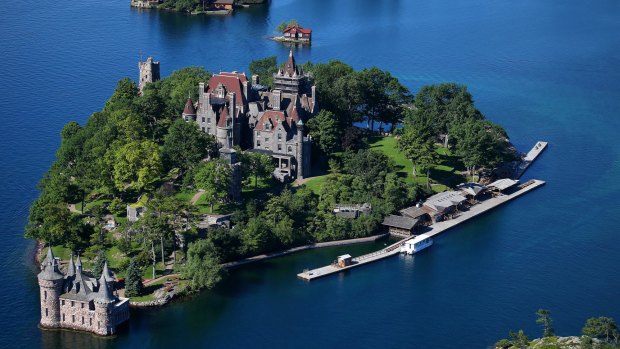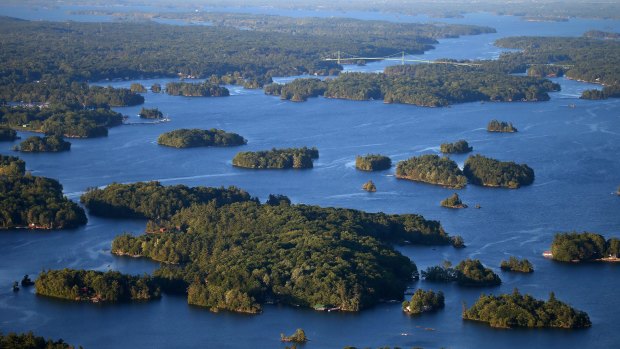This was published 7 years ago
Canada's Thousand Islands: A place, not just a salad dressing
By Kerry Van der Jagt

Boldt Castle.Credit: George Fischer
In a game of word association mention thousand islands and most people will say "salad dressing", very few will know the Thousand Islands are in fact a group of islands in the St Lawrence River between Canada and the US.
Similar to Timbuktu, the Thousand Islands sounds like a mythical or made-up place. However, from a chopper height of a few hundred metres, the sweep of furry green islands awash in a ribbon of blue are very much real.
"There's Boldt Castle on Heart Island," says pilot Rupert Owen, pointing to a tuft of green crowned with a kingdom of towers and turrets. "It's where the salad dressing began."

An aerial view of the many islands that litter the St Lawrence River between the US and Canada.Credit: George Fischer
According to legend the dressing was created when millionaire George Boldt, proprietor of the Waldorf-Astoria Hotel, asked his steward Oscar Tschirky to prepare a special dish in honour of the islands. The steward, who went on to become the famous maitre-d'hotel of the Waldorf and creator of the Waldorf salad and Oscar chicken, concocted a recipe that is still considered a secret today.
While the dressing was a success, Boldt's personal life became a Taj Mahal tragedy; his beloved wife Louise passed away in 1904 before the castle was ever finished. "Boldt was inconsolable," says Owen. "Construction stopped and the property remained vacant for over 70 years." As pretty as Heart Island is, with its romantic shape and storybook castle, it is just one of 1846 islands making up the Thousand Islands.
We've arrived in the Thousand Islands from the Canadian capital of Ottawa via the Rideau Heritage Route, seeking back roads and byways rather than big cities with their endless list of must-see attractions. To be honest I'm after the joy of slow travel, the surprises, the characters, and, if I'm lucky, a secret salad dressing recipe.
The 202-kilometre route winds beside the UNESCO World Heritage-listed Rideau Canal, a system of lakes, rivers and canals connecting Ottawa to Kingston at the head of Lake Ontario. Built in 1832, this engineering masterpiece of 47 locks, each built according to da Vinci's simple "gate" design, was a precaution in case of war with the United States. While we've allowed one day we pass plenty of people taking their time, boating and kayaking along the complete length of the aquatic highway.
A big sky opens up over rolling hills as we make our way to Chaffey's Locks, one of the 24 lockstations along the canal still operated by hand. The lock is quiet when we arrive, but lockmaster Rich Fowlie notices our interest and offers to winch it open, sending a tsunami of water spilling over the gates as he wrestles with the steel cogs. "We usually see 75 boats a day in summer," says Rich, adjusting his navy-blue overalls with pride. "Eighty-nine boats in one day is my record."
We arrive in the Thousand Islands in time for a sunset cruise, but it's not until the next morning I gain perspective of the region's vastness and beauty. Taking off from Gananoque (gan-an-ock-way) on the Canadian side of the St Lawrence River our helicopter pilot points out the international boundary, which zigzags between the islands, with New York State on one side and the Canadian province of Ontario on the other. "After the War of 1812 the Treaty of Ghent divided the islands equally," says Owen, "No individual island was allowed to be split by a border."
Swooping low we pass over a constellation of islands – Dark Island, home to Singer Castle built by the director of the Singer sewing machine company, Hub Island, with its aptly named Just Room Enough house, and Camelot Island, with its rocky cliffs and forest. Most construction took place during the late 19th century when the rich and famous flocked to the region, buying individual islands and building grand mansions as summer retreats.
The islands range from about 80 square kilometres to the size of a fishing shack, but to be included in the tally must remain above water year round and support at least one living tree. Thundering across the clear water stippled with shipwrecks and sunken villages, Owen regales us with stories about bootleggers and pirates, secret societies and hidden passageways. "Lots of shenanigans in those days," he says.
Back in Gananoque village I'm met by sandy beaches, pleasure boats, Victorian houses and a blizzard of pumpkins. It's October and the riverside town of 5000 residents is in the middle of a pumpkin festival. From my perch at the Socialist Pig coffeehouse I have a good view of the local park where children are busy carving, rolling and eating pumpkins. I join in the festivities by ordering a pumpkin pie as big as my head.
The "Pig", which is housed in an 18th-century spring and axle factory, is part of the community-focused AxleWorks enterprise, a creative conglomerate comprising a coffee shop and wine bar, street-style fashion boutique, design studio and art gallery. With a flair for design (and a love of pigs) the owners, siblings Shannon and Zachary Treanor, have brought big city chic to small-town Canada.
The streets around hum with a similar vibe; there's the Gananoque Brewing Company, serving up craft beers alongside live music; the waterfront Thousand Islands Playhouse, where guests tie up their boats in front before seeing a show; and a sculpture park on a former industrial site.
I pick up a bottle of the "Legendary Thousand Islands Salad Dressing" at one of the local stores, its heritage-style label showing a steamer ship and Boldt Castle.
When I tell the proprietor I've come from Australia for this very dressing he hands me a second bottle for free. Yes, it's that kind of town.
Over the coming days I hike a section of 40-kilometre Thousand Islands Parkway, explore parts of the World Heritage-listed biosphere and kayak among the smaller islands, all the while daydreaming about spending a summer here, buying a boat, writing THAT novel.
Talking to locals, including Michelle Caron, who is rumoured to hold the recipe, my understanding of the dressing builds – it was created for Boldt on board the steam yacht The Louise; Boldt's steward added a pickle, with the bumps representing the Thousand Islands; and since it is seasonal the dressing is only made once or twice each year. However, I never learn the recipe. "All good recipes are secret," says Caron.
Sitting on the dock on my final evening, the fall-coloured leaves reflected in the still water, I finally get it – the Thousands Islands itself is the real secret.
TRIP NOTES
MORE INFORMATION
GETTING THERE
Air Canada flies daily from Sydney to Vancouver and then on to Toronto. It also has connections to Ottawa. Melbourne passengers fly to Sydney for connections. See aircanada.com
STAYING THERE
Gananoque Inn and Spa is a historic waterfront property on the St Lawrence River. Fireplace rooms in the Main Inn start from $C155. See gananoqueinn.com
SEE + DO
1000 Islands Helicopter Tours offers an 18-minute Boldt Castle scenic flight out of Gananoque for $C149pp. See fly1000islands.ca
Kerry van der Jagt was a guest of Destination Canada and Ontario Tourism
Sign up for the Traveller Deals newsletter
Get exclusive travel deals delivered straight to your inbox. Sign up now.